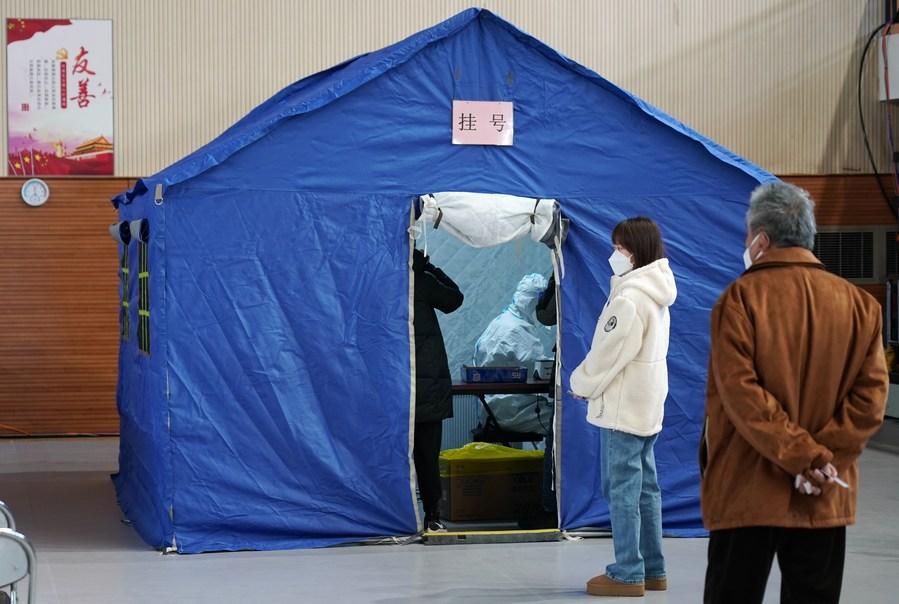

People line up to seek medical advice in a makeshift fever clinic in Guang'an Gymnasium in Beijing, capital of China, Dec. 24, 2022.
[Photo/Xinhua]
As multiple regions in China have seen surging COVID-19 infections, local governments are taking swift and precise measures to prevent severe cases, protect people's health, and build a barrier against the epidemic.
These measures include providing timely medical treatment, meeting medicine needs, improving health services for the elderly and other key groups, promoting COVID-19 vaccination, and strengthening epidemic prevention and control in rural areas.
Bolstering medical resources
Medical institutions at all levels are optimizing procedures, expanding resources, increasing the medical workforce, as well as coordinating COVID-19 patient treatment and daily medical services.
In Shanghai, fever clinics in 145 secondary and higher-level hospitals have been asked to fully open to meet the needs of people for medical services.
The Huashan Hospital Affiliated with Fudan University in Shanghai has set up outdoor emergency and fever clinic pre-examination windows. In order to ease the pressure of receiving patients and expand its capacity, the hospital has reserved intestinal clinics as a backup in addition to the original fever clinics. Medical staff with experience in epidemic prevention and treatment have been encouraged to establish a reserve talent pool.
Hangzhou and other cities in east China's Zhejiang Province have opened internet hospitals in response to the high demand for diagnosis and treatment in fever clinics.
The Sir Run Run Shaw Hospital, affiliated with Zhejiang University School of Medicine, launched a green channel for the rapid COVID-19 consultation on Dec. 9. Since then, a total of 72 experts from departments such as infection and respiratory medicine have provided 24-hour online services and more than 8,400 online consultations have been conducted so far.
The treatment of critical COVID-19 patients is one of the current priorities for medical institutions. The Xinhua Hospital affiliated with Shanghai Jiao Tong University School of Medicine has added intensive care beds for adults and children.
Protecting key groups
The National Health Commission has asked grassroots medical institutions to set up ledgers for special groups such as the elderly living alone, pregnant women and patients with underlying health conditions, to ensure necessary medical services.
In the city of Xiangtan in central China's Hunan Province, the family doctor team of the Yuetang sub-district's community health service center provides home medical services for the elderly with underlying diseases or other vulnerable groups in need.
After China optimized the epidemic prevention and control response, the residential communities shifted their focus to guarantee medical treatment services and provide health investigation, drug delivery and other services for residents.
At the community health service center of Dapuqiao sub-district in Shanghai's Huangpu District, family doctor Wu Shuyao was seen carefully assessing the health status of residents, paying special attention to the elderly over 80 years old, patients with chronic diseases, hemodialysis patients, cancer patients and pregnant women. Wu provides them with medical guidance via telephone and video.
The Yongsheng Community in Kuancheng District, the northeastern Chinese city of Changchun, has set up a volunteer service team to meet the residents' demand for the distribution of medicines, daily necessities, and other materials.
In Pingguoyuan sub-district of Beijing's Shijingshan District, a team, consisting of five to six community workers and medical staff, provides door-to-door vaccination services for the elderly every Tuesday, Thursday and Saturday afternoon.
Enhancing health services in rural areas
Grassroots governments are improving health services in view of the relative shortage of health resources in rural areas and the increase in population mobility and the return of migrant workers during the upcoming New Year and Spring Festival holidays.
The Linxiang municipal health commission in Hunan Province, together with local medical institutions, compiled the guidelines for epidemic prevention and health awareness manuals and distributed them to villagers. Family doctors have been creating awareness among villagers about the correct use of medicines.
The health center in Tandu Township, Linxiang, has set up a fever clinic with medical staff on duty 24 hours a day. The fever clinic has seen dozens of patients every day, with three doctors taking turns on duty. A batch of emergency medicines, including antipyretics, are also available in the fever clinic.
In the city of Jiaozhou, east China's Shandong Province, the municipal health commission has set up 536 community medical points and organized 446 medical personnel and volunteers to provide medical services to villages. There are at least two medical personnel in each village clinic and medical point offering 24-hour medical services such as consultation, medicine dispense, and patient transfer for key groups.
Ye Shanyu, an attending physician of the central health center of Jiaodong sub-district in Jiaozhou, distributed health kits to residents in Damawan Sancun Village. "Many villagers are concerned about the correct use of medicines. After my explanation, the people's concern subsided," Ye said.
